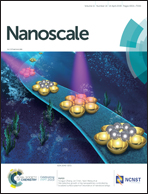Small-angle neutron scattering studies of pore filling in carbon electrodes: mechanisms limiting lithium–air battery capacity†
Abstract
Many obstacles impede the development of Li–air batteries for practical applications. In particular, there is lack of understanding of the dynamics of processes occurring in porous air electrodes during discharge, including oxygen transport limitations, pore clogging and electrode passivation by both insulating discharge and parasitic reaction products. Here, using small-angle neutron scattering, which provides information on the whole electrode adequate to electrochemical data, we uncover the mechanisms limiting the Li–O2 porous carbon electrode capacity by analysis of the cathode pore filling in highly and poorly solvating media – dimethyl sulfoxide and acetonitrile. The results obtained allowed us suppose that in both cases the cell death is mainly triggered by blocking of oxygen transport pathways inside carbon black particle agglomerates. Total discharge capacities are, indeed, higher in highly solvating solutions due to a higher discharge intermediate lifetime and longer diffusion distance, which enable Li2O2 formation outside the carbon black agglomerates, which are, as we demonstrated, in fact mesocrystals that are confirmed by the appearance of a diffraction peak in scattering curves.



 Please wait while we load your content...
Please wait while we load your content...